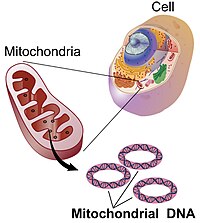
Photo from wikipedia
Mitochondria are ATP-generating organelles in eukaryotic cells that produce reactive oxygen species (ROS) during oxidative phosphorylation (OXPHOS). Mitochondrial DNA (mtDNA) is packaged within nucleoids and, due to its close proximity… Click to show full abstract
Mitochondria are ATP-generating organelles in eukaryotic cells that produce reactive oxygen species (ROS) during oxidative phosphorylation (OXPHOS). Mitochondrial DNA (mtDNA) is packaged within nucleoids and, due to its close proximity to ROS production, endures oxidative base damage. This damage can be repaired by base excision repair (BER) within the mitochondria, or it can be degraded via exonucleases or mitophagy. Persistent mtDNA damage may drive the production of dysfunctional OXPHOS components that generate increased ROS, or OXPHOS components may be directly damaged by ROS, which then can cause more mtDNA damage and create a vicious cycle of ROS production and mitochondrial dysfunction. If mtDNA damage is left unrepaired, mtDNA mutations including deletions can result. The accumulation of mtDNA mutations has been associated with conditions ranging from the aging process to cancer and neurodegenerative conditions, but the sequence of events leading to mtDNA mutations and deletions is yet unknown. Researchers have utilized many systems and agents for generating ROS in mitochondria to observe the downstream effects on mtDNA, ROS, and mitochondrial function; yet, there are various drawbacks to these methodologies that limit their precision. Here, we describe a novel chemoptogenetic approach to target oxidative damage to mitochondria and mtDNA with a high spatial and temporal resolution so that the downstream effects of ROS-induced damage can be measured with a high precision in order to better understand the mechanism of mitochondrial dysfunction in aging, cancer, and neurodegenerative diseases.
Journal Title: Biomedicines
Year Published: 2022
Link to full text (if available)
Share on Social Media: Sign Up to like & get
recommendations!